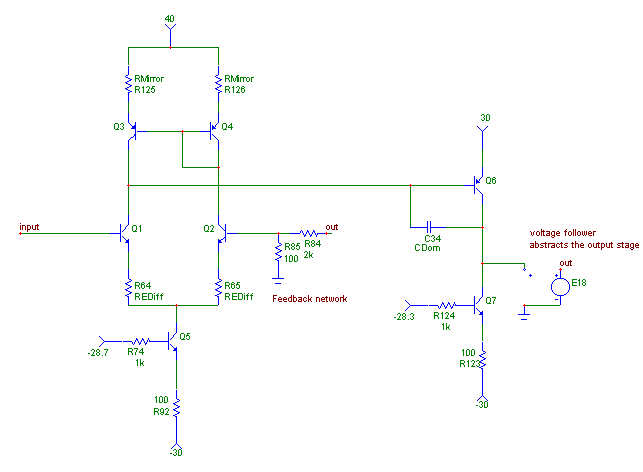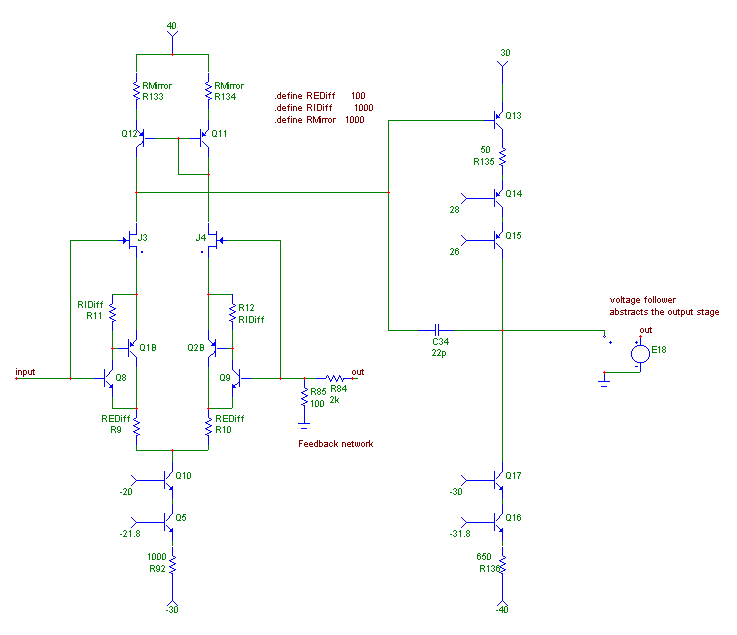
Fig. 6-1 : Basic configuration
It has amused me to read Douglas Self's Audio Power Amplifier Design Handbook. While this book contains a wealth of useful ideas, is really well written and scientifically-minded, it never mentions listening tests. What is the purpose of an amplifier, after all ? Do you listen to music to take the dust off the speakers, or to move your inner self ?
Self's book is compulsory reading for anyone wishing to design a power amp. I would ever have been able to design mine without this book. It is very competently written and interesting. However, we will proceed to the listening tests.
I used headphones for all my prototypes. There is no way I'm going to build a full power version of the amplifier straight away : when I burn 10 ouput transistors in two hours, they better be $0.50 ones that drive headphones, than $5 ones that drive speakers. Besides, the Sennheisers 580 allow me to hear many things that, on speakers, could have been masked by the imperfections in the room, speakers, whatever. And finally, my speakers are bi-amped, so that ended the debate.
So, the amp was coupled to a simple output stage powered by BD139/140, with drivers, a Vbe multiplier, and a buffer to protect the VAS from them. This is quite typical indeed. I tried single ended output stages too, but I didn't like the sound of them. Not enough balls.
| Case | Test Setup | Memory (Simulated) | What it sounded like... |
| 1. | Basic configuration (Fig. 6-1), with the current sources from the Advanced version (Fig. 6-2), and 1000R current mirror resistors. | Very high | Like solid state, harsh, grainy. You know the story. Bleh. |
| 2. | Like 1, + Cascoded VAS | High | Better. Still solid-state, but less harsh. On the good way. |
| 3. | Like 2, +JFETS in the input stage | Medium | Much better than 2, more fluid, more musical. Starts to get enjoyable. |
| 4. | Like 2, with CFP in the input stage | Medium | Similar to 3, but maybe a little bit of a muffled, dark sound. |
| 5. | Cascoded VAS + New input Stage | Low | Another big step forward. Music really gets enjoyable ! Solid-state hash is almost gone ! What remains could come from the CD player. The amp has almost no sound of its own, as the ambience changes completely from recording to recording. On some, it sounds genuinely Live. Goosebumps are there ! |
Scroll down please...

Fig. 6-1 : Basic configuration |

Fig. 6-2 : Advanced configuration |
So, the listening tests seem to confirm that minimizing memory is a good step towards improving subjective sound quality. Personnally, I have a problem here, as I can't listen to my stereo anymore. I just can't stand anymore how harsh, how solid-state it sounds. I spend hours listening to my prototype on the headphones instead, and I like it.
Well, plenty. Two practical things, first :
And then, turning this prototype into a full-blown amplifier. It is going to take a lot of polishing.
The saturation problem is not solved yet. I will do another chapter on this, but as far as we are, now, when the amp clips, it gets as much memory as the very first prototype. This is very bad and has to be dealt with. I can't hear it with headphones, though, as I would be deaf before it clips... have you heard many headphone amps that can output 20V RMS ?
I am a little tired of all this writing. So, while I go rollerblading a little, please think about it and email me your feedback ! There are probably many typos, as I wanted this to be available early to keep the TNT amp project running...
Pierre Frédéric